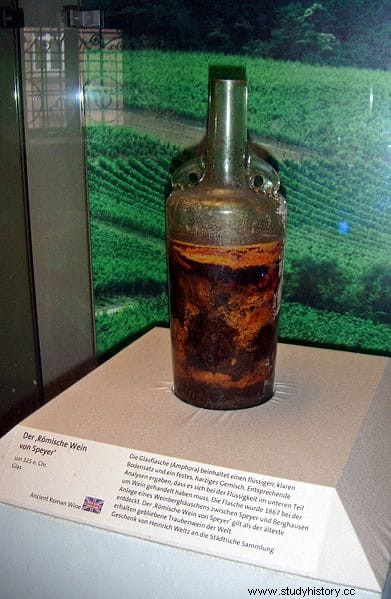It is considered that a wine it is aged when it has undergone an aging process of at least twenty-four months, either in oak barrels or in the bottle.
And, although it is popularly believed -erroneously- that the older the better the quality, one would have to ask until what date would one be willing to go back to taste a wine:five years, ten, twenty? How about millennium and a half ?
That last expression is not a joke; This is the estimated age of the oldest unopened bottle of wine that is preserved, the so-called Römerwein , found in 1867 during excavations to make the foundations of a building near the city of Speyer , in the Rhineland-Palatinate region of Germany, where a Roman settlement was known to have occurred from the 4th century AD
It turned out that there, in the basement, was the tomb of a nobleman :Two stone sarcophagi appeared containing two bodies, one male, identified as a soldier, and another female whose identity was not specified. As interesting as it was per se This discovery, more it turned out to see that in each of the coffins there was an unusual trousseau.
Indeed, the man had been buried withten bottles of wine and the woman with six others , all glass, supposed to be placed there to accompany them on their journey to the afterlife. The great surprise for the archaeologists was that although the other vessels were broken, one was still whole and in good condition . It had the appearance of an amphora and even had small handles that took the shape of dolphins, as well as the classic Roman wax seal-stopper, but it was not made of ceramic but of glass yellowish green. Chronological dating places it between the years 325 and 350 AD

But things could still be improved:inside the container, occupying approximately a third of the total, there was still liquid . It is difficult to ensure that it is wine or that, at least, it can continue to be called that; not only because of the whitish color acquired over the centuries, but also because it seems likely that the taste is no longer similar, having lost the ethanol and become considerably vinegary.
They say that during the First World War it was analyzed by German chemists who concluded that it was indeed wine but that it could be poisonous. However, it is not clear that this happened, so it is considered that the bottle is still sealed.
In fact, lately the possibility of opening it and performing an analysis has been considered. Now, not everyone welcomes the idea because they believe that contact with the air could spoil more the broth, hence the vessel has remained closed for practically the last century. Thanks to this, explains Ludger Tekampe , the content does not appear to have undergone any appreciable change. Tekampe, curator of the Historische Museum der Pfalz (Pfalz Historical Museum), the institution that keeps the Römerwein as one of its star pieces, it shows certain misgivings when opened because it is not known how the wine would react when the stopper is removed, not counting the risk of breakage of the bottle.
Monika Christmann , a professor of oenology at the Hocschule Geisenheim (the university of Rheingau, a wine-producing region of the state of Hesse, Germany's main producer) is somewhat humorous in her opinion that the wine "is probably not microbiologically spoiled, but it will not bring joy to the palate» .
However, it must be taken into account that the wine, probably produced in Germany, was seasoned by the Romans with a mixture of herbs and a good dose of olive oil was also added. so that it would form a layer on top, keeping it protected and facilitating its conservation, especially since it is not in an amphora but in an unusual glass container.
In other words, unless things change, oenologists and the curious will be left wondering how the oldest wine that is preserved in a liquid state tastes and smells (there are samples from other sites dating back to six thousand years B.C. but in a solid state, lees in powder form). Curiously, in the Historische Museum der Pfalz you can also see the oldest existing bottle with liquid German wine. :a wine harvested in 1687 at the Steinauer vineyard near Naumburg.
